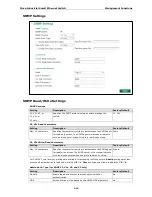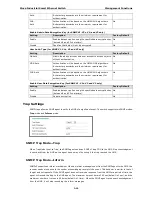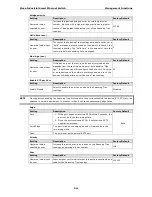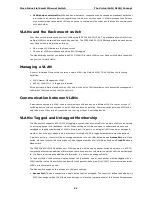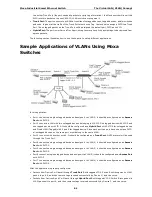
Moxa Industrial Smart Ethernet Switch
The Virtual LAN (VLAN) Concept
B-2
•
VLANs help control traffic: With traditional networks, congestion can be caused by broadcast traffic that
is directed to all network devices, regardless of whether or not they need it. VLANs increase the efficiency
of your network because each VLAN can be set up to contain only those devices that need to communicate
with each other.
VLANs and the Rackmount switch
Your Moxa switch provides support for VLANs using IEEE Std 802.1Q-1998. This standard allows traffic from
multiple VLANs to be carried across one physical link. The IEEE Std 802.1Q-1998 standard allows each port on
your Moxa switch to be placed as follows:
•
On a single VLAN defined in the Moxa switch
•
On several VLANs simultaneously using 802.1Q tagging
The standard requires that you define the
802.1Q VLAN ID
for each VLAN on your Moxa switch before the switch
can use it to forward traffic.
Managing a VLAN
A new or initialized Moxa switch contains a single VLAN—the Default VLAN. This VLAN has the following
definition:
•
VLAN Name
—Management VLAN
•
802.1Q VLAN ID
—1 (if tagging is required)
All the ports are initially placed on this VLAN, and it is the only VLAN that allows you to access the management
software of the Moxa switch over the network.
Communication between VLANs
If devices connected to a VLAN need to communicate with devices on a different VLAN, a router or Layer 3
switching device with connections to both VLANs needs to be installed. Communication between VLANs can
only take place if they are all connected to a routing or Layer 3 switching device.
VLANs: Tagged and Untagged Membership
The Moxa switch supports 802.1Q VLAN tagging, a system that allows traffic for multiple VLANs to be carried
on a single physical link (backbone, trunk). When setting up VLANs you need to understand when to use
untagged or tagged membership of VLANs. Simply put, if a port is on a single VLAN it can be an untagged
member, but if the port needs to be a member of multiple VLANs, a tagged membership must be defined.
A typical host (e.g., clients) will be an untagged member of one VLAN, defined as an Access Port in a Moxa
switch, while an inter-switch connection will be a tagged member of all VLANs, defined as a Trunk Port on a
Moxa switch.
The IEEE Std 802.1Q-1998 defines how VLANs operate within an open packet-switched network. An 802.1Q
compliant packet carries additional information that allows a switch to determine which VLAN the port belongs
to. If a frame is carrying the additional information, it is known as a
tagged
frame.
To carry multiple VLANs across a single physical link (backbone, trunk), each packet must be tagged with a
VLAN identifier so that the switches can identify which packets belong in which VLAN. To communicate between
VLANs, a router must be used.
The Moxa switch supports three types of VLAN port settings:
•
Access Port: The port connects to a single device that is not tagged. The user must define the default port
PVID that assigns which VLAN the device belongs to. Once the ingress packet of this Access Port egresses

